Copyright 2020 - 2021 irantour.tours all right reserved
Designed by Behsazanhost
Esfahan: Different religions underneath a sky
Esfahan: Different religions underneath a sky
Different religions live in peace and tranquility in Isfahan.
Isfahan has always been the place of life for different nationalities and religions. In the immigration of believers in various periods, it had been the main target of immigration. Isfahan due to its special geographical position and its location in the center of Iran usually had been a major city for immigrants from all over Iran. Jews have settled in Isfahan since ancient times also the Zoroastrians had been living there for different periods.
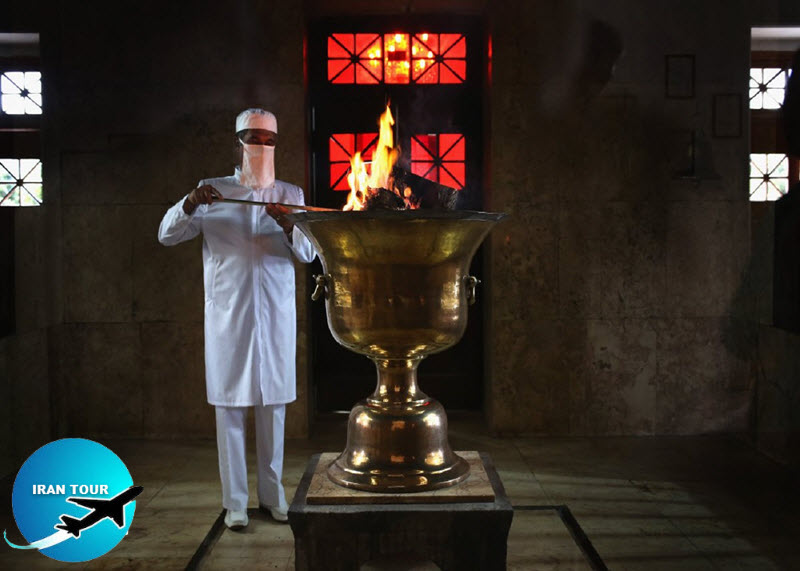 |
The Zoroastrians of Esfahan
Zoroastrians are amongst the initial citizens and the local people of Iran. Gabay. Gay or Jey lived in the two ancient and historical Sarouyeh and Mehrin, now known as "Tappeh-e-Ashraf and Atashgah Spectively. Regarding this fact, the only
After the conquest of Esfahan by the Arabs, (7th century), the local people had three choices: first, to stay in their homeland and pay annual taxation (Jazieh); second, to convert to Islam, or third, to emigrate from the homeland to the eastern lands. According to the chronicles of Esfahan, one can rarely find any information about these followers of Ahura Mazda (the God of this monotheistic religion). History has it that they were living in the south of the Zayandeh Rood and on the east of the Julfa Quarter in a parish called; Gabre Abad during the Safavid Dynasty. Concurrent with Shah Abbas II reign, due to the Sufis'
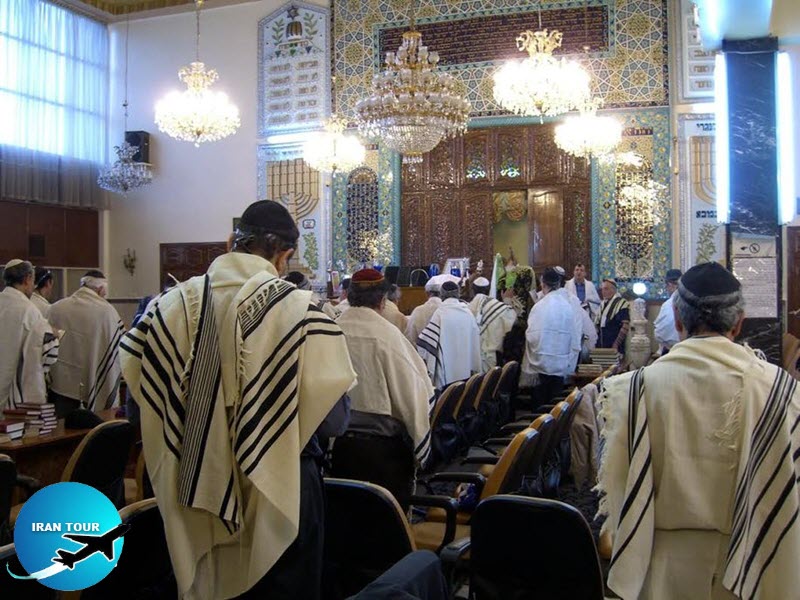 |
The Jews and the Historical Background of their residence in Esfahan
According to the chronicles of geographers and travelers of the 17th century, there existed initially two residential areas in Esfahan. One was Yahudieh Jew Quarter and the other one was known as Jey or Shahrestaneh, Muslim Quarter Vahudieh was about two times larger than Jey and its Jewish inhabitants misrated here since they could not tolerate anymore the endless cruelties of Nebuchadnezzar II, the Chaldean King of Babylon (Bokht-
In 1954 A.D., during the renovation of the ceiling of a synagogue called: Jacob (Yaghub) in the old cemetery of Esfahani Jews, Estera Khatoon in Pir-
At present, the Jews of Esfahan have a population of 2500 persons. In Iran, their population is about 40,000 that in descending order are living in Tehran. Shiraz, Esfahan mostly in Joubareh quarter and Hamedan. The Jewish community in Iran has one representative in the parliament. Joubareh is located between Namal Ave. and 'Vali-e-Asr' Ave., and the existing synagogues mostly are not older than 100 years.
The plan of the prayer halls is usually square with a platform of 3 meters by els and 80 centimeters high, for a preacher in the middle and a central vault with four columns tied together by wooden beams at the level of according to religious instructions since ancient times, the Jews used the basement of their houses so deep that they reached the level of the ole by moving a considerable amount of earth, typified by stairways, It was considered a holy place called Mighveh. The main fun place. .we obligatory ceremonial washings of ladies practiced in such a long time, owing to its ideal thermal insulation against tempera were also used as a suitable place for some public gatherings, serving food, mostly decorated with tilework displaying Hebraic supported with four columns tied together vault base. According to religion to design the basement of the water table by moving a con leading to the water. It was consideration was for the obligatory cere place. Over a long time, o true fluctuations, it was also Testing, and preserving food, and inscriptions of some holy verses.
After a long quest, finally, we could find two Mighvehs respectively in Keter Davoud, built-in 1944 A.D., and Gol Bahar synagogue. (see the photos). Let it remain unsaid that Gol Bahar Synagogues is one the oldest synagogues in Iran situated in the middle of an old quarter by the same name. Its Mighveh basically survives but is dry due to water table subsidence. The present building is the same as the level of
The Armenians of Julfa (Aras) The Instigators for the Freedom of the Northwestern Parts and Economical Blossoming of Iran
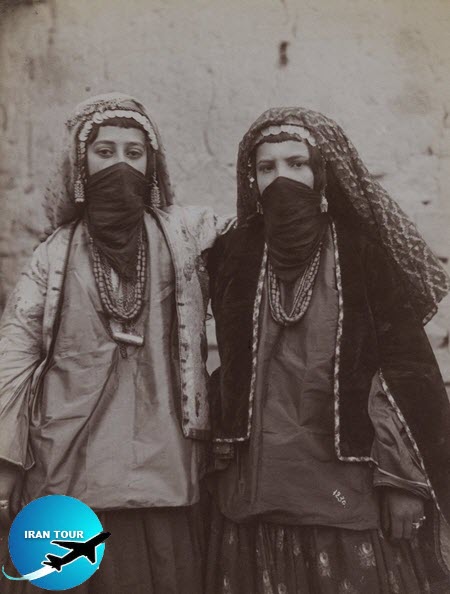 |
After the appointment of Esfahan as the capital by Shah Abbas I. in 1591 A.D., until the capital was relocated from Oazvin to Esfahan, he was always at war with the Uzbeks and Portuguese, in the north and south respectively, and the superpower of the age, the Ottoman Empire on the west. They had occupied some parts of Iran during the reign of Shah Abbas's father, and he was the heir to those struggles.
The Safavid king paid attention closely to the Uzbeks and Portuguese first and second, after their expulsion from the lands, focused on the Ottomans later. During this period, he encountered a large number of immigrants, who were the targets of tremendous cruelty by the Ottomans from the occupied lands in the northwest parts.
In 1600 A.D., a high-ranking group from Armenia came to Esfahan to invite Shah Abbas I, to release Armenia-a changing point for the king about the northwestern lands. He accepted their invitation gladly. The heads of this group were Melikset, Manuel, Geghard, and Tadev who offered precious gifts to the king, and in turn, were received warmly and given promises to be joined to Iran again. Finally, in September of 1603 A.D., Shah Abbas I, pretended that he wanted to go hunting in Mazandaran with a limited number of his best soldiers, but instead, they moved fast towards Tabriz, Nakhichevan, and finally Armenia to free those territories. The people of those regions were so surprised that for receiving Shah Abbas I, in Armenia, they spread precious carpets and silk textiles on his way between the Aras River Bridge and the house of Khaje Khachic. The king found chormous economic potentialities in Armenia. For example, one of the gifts presented to the king was a tray filled with gold coins that Khaje Nazar, one of Khachic's sons, offered to the king.
At that moment, Shah Abbas I, was faced with these problems: first, he knew Ollomans enjoying an army of more than 200,000 well-equipped soldiers were ready to take back the released lands. Second, he didn't want to miss the economic opportunities of Armenians by the knowledge that the Armenian's experience in the field of international trade could revive the economy of the capital. Finally, he came up with the idea to deport Armenians from their homeland to decrease the motivation of the Ottomans about Occupying the lands on the borders again. There are so many contradictory figures concerning the number of immigrants that in some references, it exceeded 400.000 people. It is estimated that the number of Armenians who arrived in Esfahan in 1606 A.D. was 30-40 thousand people.
After arriving in Esfahan, they were accommodated in the northwestern part of the capital, and the property right of those lands was formally donated to them. At the same time, the experienced team of builders and artists was at the service of the Armenians in Esfahan, and according to history, their new town was called New Julfa. Armenians enjoyed a wide range of liberty, security, and relative independence.
The community was so highly favored by the king that, in some cases, he was accused of his willingness to Christianity. But, he was pretending so as to unify with the Europeans to exert dual pressure on the Ottomans (their common enemy) from the west and east. Armenians built 25 churches in New Julfa, inter alia, 13 still remain in good condition after four centuries. About the administrating system of Julfa, it was a self-administration by Khaje Nazar under the supervision of the central government. The family of Khaje Khachic was so powerful and rich that they could play an influential role between the Armenians and the central administration. After the death of Khaje Nazar in 1636 A.D. his son. Khaje Sarfaraz was appointed as the head of the community. According to history, Marnan Bridge was built by Sarfaraz and that is why in some references his name is used for the bridge.
Armenians enjoyed a long-term experience of trade with Europe because they were commercially-minded people and had the same Christian cultural commonalities for more success in this field. According to the travelogue of Chardin, the French traveler, never had he seen anywhere such a well-organized town as New Julfa, and he adds that in this region he could find more than 140 private houses which were as fine as the royal palaces in Esfahan. There is a story that goes: One day, the head minister of Shah Abbas II, reported to the king, "Your Majesty, do you know that in your lands where you are the Emperor, some citizens are richer than you?" And when the king was amazed and wondered to know who was so rich he replied, Khaje Petros Vellijanian. It was reported that if he changed all his capital to silver coins and put them in cotton bales and put in the 21 sluices of the Khajou Bridge, the passages of running water in the Zayandeh Rood would be blocked.
According to history, except New Julfa only a limited number of Armenians were accommodated in some other quarters of Esfahan, but they were all transferred to New Julfa, too. Armenians established their own training system New Julfa consisting of an international trade school headed by constantly had listed, the trade partners of the Armenians all over the world, and this list is still available.
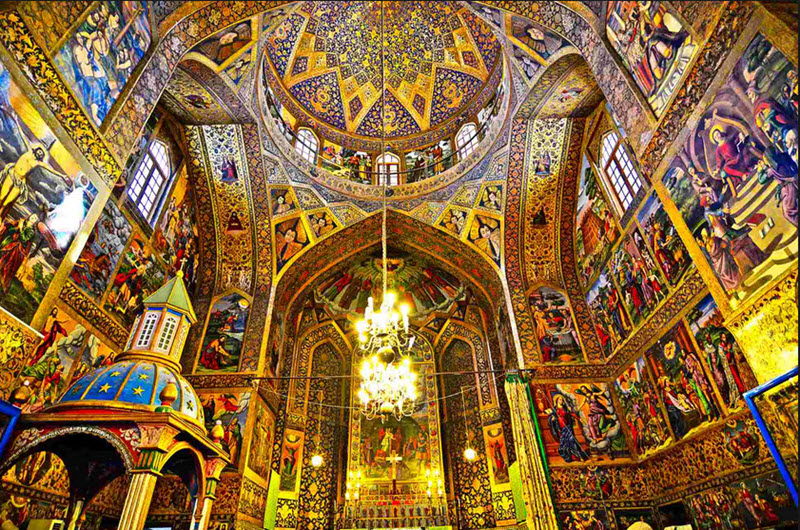 |
Julfa Quarter and its Armenian Churches
To accommodate the Armenians, who immigrated from Aras Julfa to Esfahan, a new parish was established for them called: New Julfa. Much liberty and concessions were granted to this community to practice their own religious and traditional ceremonies. Then, the Armenians appointed their own administrator to handle their affairs, and the land rights (demurrage) were conceded to them by the order of Shah Abbas I, as a particular residential area for the Christians in 1604 A.D. After their settlement in this region, they built gorgeous houses, schools, public bathhouses, arcades squares, covered bazaars, and caravansaries led to a piecemeal improvement in the transaction of business with merchants of different nationalities.
At the same time, the role of religion was not disregarded. The first Armenian church founded in 1604 AD was called, Jacob (Hacop) Then, in 1606 A.D., another church was built. Amena Perge. Afterward, the number of prayer halls, monasteries, and churches mushroomed rapidly. In 1655 AD., a large cathedral was erected and used instead of Amena Pergaij, called; Vank (All Saviour's). The established churches in the region until the end of the 18th century A.D. exceeded 24. The Armenians of Esfahan are Orthodox and the followers of Saint Gregory, the Illuminator (the Gregorian church, is an independent Christian communion and one of the most ancient of the Orthodox Christians). Among the other Christian sects, they are of the first followers of the Apostle Church community who accepted this religion, by the efforts of Saint Gregory, at the beginning of the 4th century 302 A.D. Thereby, a different genre of painting, which was an amalgamation of Iranian,
first printed book was the Psalms of David (a copy of which is on display in the museum of the Cathedral). The Julfa Quarter, as a Christian parish, was chosen by foreigners of different nations, as a suitable area so that a large number of representatives of companies and travelers could be found there. At present, the Armenian community has 8 educational centers, from kindergarten to senior high school, in Esfahan. The New Jolfa's bishop is the Right Reverend Shahin Sarkisian. The population of Armenian in Esfahan and Shahin Shahr is approximately 8000, but the total population of Armenian in Iran amounts to 130,000 which has two representatives in the parliament. The Assyrian community is about 20,000 who are Catholic, Protestant, and Orthodox that have one representative in the parliament
The following is a list of 13 existing historical churches in Esfahan:
1. Saint Jacob (Hacop)-1604 A.D.
2. Amena Pergaij -1606, A.D.; expanded as Vank (All Saviour's) Cathedral-1655 A.D.
3. Saint George-1611 A.D.
4. Saint Mary -1613 A.D.
5. Saint Stephan (Sarkis)-1614 A.D.
6. Saint John, the Baptist -1621 A.D.
7. Saint Catherine-1623 A.D.
8. Saint Bethlehem-1628 A.D.
9. Saint Nicholas -1630 A.D.
10. Saint Gregory, the Illuminator -1633 A.D.
11. Saint Minas -1659 A.D.
12. Saint Sarkies -1659 A.D.
13. Saint Nerses -1666 A.D.
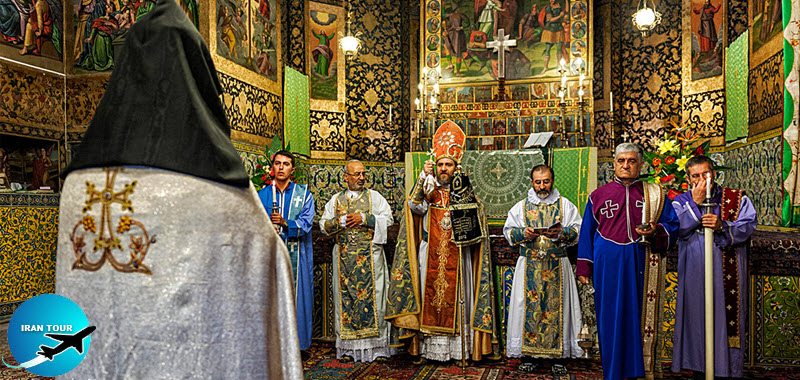 |
This cathedral is located on Nazar-e-Sharghi' Ave. in an alley called; Kelisa (Church) as a congregational church of Esfahan. It was built initially as a small Church called; Amena Pergaige in 1606 A.D., and then expanded to its present size later in 1655 A.D., with a gorgeous nave topped by a 38- meter lofty double-layer dome. The nave is adorned all over by mural paintings, including three genres of Iranian miniature, Armenian, and Byzantine either individually or synthetically. On the lower part of the polychrome tilework, which is mostly similar to the arabesque designs of mosques, some realistic patterns are more similar to the Armenian style designed.
On the northern part of the courtyard, two buildings of the library and a museum exist, of which the former dates back to the early 20th later to 1971 A.D. There is also a symbolic structure (cenotaph) on the western part of the library in memory of those Armenians, in the genocide committed against them during the First World War in 1915 A.D. by the Ottoman Turks.
The museum is a two-story building, founded in 1971 A.D., displays much interesting anthropology, carved wooden crosses, porcelain dishes, etc., donated by the Armenian community acts such as old religious books, and some aspects of the Armenian. The archbishop of the southern and central Armenians in Iran lives in Vank Cathedral, an old two-story building from the early 20th century. Also, 62 tombstones are located in the inner space of the church, among those buried, 24 are clergymen, 36 politicians, physicians, and also, two unidentified persons.
- Details
- Category: IRAN Blog